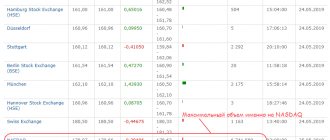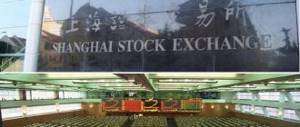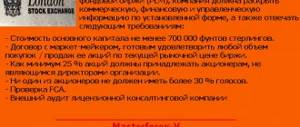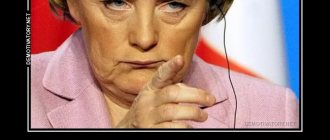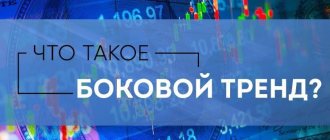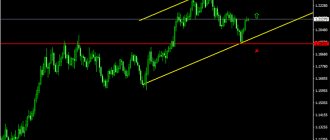Lazy Investor Blog > News
Against the backdrop of another currency crisis, the official exchange rate of the Central Bank of the Russian Federation is perhaps the main news in the media. Anyone who checks stock market reports sees that its value differs from market quotes: sometimes by a ruble or more. Today we’ll talk about what causes this situation. We’ll also see how the Central Bank’s data on the exchange rate affect investors.
I recommend starting your study of the article with the video.
Andrei Kostin criticized the Central Bank: the creation of a system of banks managed by the Central Bank is contrary to logic
The creation of a system of banks managed by the Central Bank is categorically contrary to any logic and any laws of development of the financial sector, because the regulator cannot and should not, of course, be the owner of its own banking system,” Kostin said. His words were reported by Vedomosti with reference to Bloomberg.
Andrey Kostin, VTB
In his opinion, the Central Bank is unlikely to be able to withdraw from banks’ capital, despite statements about the temporary nature of this measure. “Due to international restrictions and Basel requirements, I think that investment capital today will generally not come to the banking sector. It just won’t come,” explained the VTB president.
Citizens will be able to evaluate the quality of the Bank of Russia’s responses to their requests
The Bank of Russia has launched a free SMS message service, with the help of which it invites citizens to evaluate the quality of the answers provided to them by the regulator through the Internet reception. Such a mechanism will improve the efficiency of handling requests from consumers of financial services, writes bankir.ru.
In this case, all SMS messages on behalf of the Bank of Russia will come from the short number 3434. The consumer will be asked to evaluate how fully and efficiently the Bank of Russia responded to his request. This can be done by giving a rating from 1 to 5 points. The response SMS will be free for the citizen.
The regulator reminds that any messages from numbers other than 3434 on behalf of the Bank of Russia, including those requiring the entry of a PIN code, confirmation of transactions, provision of personal data, and others, should be regarded as fraudulent actions.
The collectors will be handed over to the investigation: the FSSP has found justice for illegal collectors
Market participants told Kommersant that the FSSP (the collection market regulator) for the first time initiated a pre-investigation check of the activities of collectors who are not on the state register by the Investigative Committee.
The regulator saw in the actions of Gudermes Collection the incitement of hatred or enmity, as well as humiliation of human dignity on the basis of gender, race, nationality, language, origin, as the companies tried to put pressure on debtors by posing as representatives of the Caucasian diaspora. During the FSSP inspection, it turned out that agencies with the indicated names are not on the state register (from January 1, according to 230-FZ, collectors can collect debts only if they are on the FSSP register).
Auditors are pushing for their reform: the market is asking to speed up the adoption of the relevant law
The adoption of a law providing for audit reform by the end of the year was in question, Kommersant learned. When preparing a government response to the project, the Ministry of Finance saw a conflict of interest among the mega-regulator and is now looking for solutions. And although the Central Bank promises to avoid conflict, the passage of the document is stalled. The auditors themselves, tired of uncertainty, are trying to move the situation forward.
Anton Siluanov, Ministry of Finance of the Russian Federation and Igor Shuvalov, Government of the Russian Federation
“In the course of preparing the government’s response to the draft federal law regarding vesting the Bank of Russia with powers in the field of auditing activities, the need to prevent a conflict of interests of the Central Bank is being considered,” the Ministry of Finance notes. “In particular, the bill should establish specific mechanisms for preventing such a conflict, as well as ensuring independence of audit organizations that audit the reporting of the Bank of Russia itself, as well as other organizations over which the Bank of Russia carries out systematic supervision.”
Good from the word “not very”: banks summed up the financial results of the ten months of 2021
Growth in retail lending has slowed, and corporate lending is stagnating. Loan arrears are increasing again. Depositors are reluctant to take money to banks. Sberbank and VTB Group banks are breaking records in terms of profit, while FC Otkrytie and B&N Bank are showing record losses. This is how bankir.ru describes the results of ten months of 2017.
In general, in January–October 2021, the main performance indicators of banks grew slowly, excluding the impact of currency revaluation. According to the Bank of Russia, bank assets in January–October 2017 increased by 5.7%, and the total volume of loans to the economy (enterprises and households) increased by 4.7%. In January–October 2021, the volume of loans to enterprises increased by 2.9%, and the volume of loans to individuals by 9.8%.
Banks with the maximum loan portfolio size
Source: data from the Bank of Russia and the banki.ru portal.
Russia has become the leader in payments using phones
Russia ranks first in the world in the number of transactions through the Android Pay system, which allows you to pay in stores by touching your smartphone to the terminal. This follows from the speech of Visa Russia CEO Ekaterina Petelina at the Russian Financial Forum, organized by Vedomosti.
And if we take into account payments through Apple Pay, then Russia ranks third after the United States and Great Britain and is far ahead of other markets, Petelina added.
VTB will replace Sberbank ATMs in the Moscow metro with its own
VTB began installing ATMs in the Moscow metro at the end of October this year, the bank’s press service told RBC. “In total, it is planned to install 94 devices at 65 stations, of which 30 ATMs have already been installed,” VTB clarified.
The installation of ATMs is carried out as part of the fulfillment of the terms of the Moscow Metro tender, which the bank won on September 12, 2017 for a period of five years. In addition, VTB is implementing an acquiring project for non-cash payment of travel and replenishment of the Troika card using a bank card, as well as a salary project for metro employees, the press service added.
At the same time, Sberbank, whose 101 ATMs were installed in the metro as part of the tender, is dismantling its devices, according to information on the government procurement website.
What's in the past
To begin with, let’s immediately decide what is no longer relevant. Since many of these terms are still commonly heard, it is worth talking about them.
MICEX, or Moscow Interbank Currency Exchange . existed until 2012, after which it finally merged with the RTS under a new name, Moscow Exchange. The MICEX was the first systematic platform for currency trading after the Soviet currency exchange of the State Bank, where since 1989 there have been auctions for the sale of the US dollar, conducted by Vnesheconombank. The weighted average rate, which was formed at MICEX trading, was taken as the official ruble exchange rate established by the Central Bank of Russia.
Dual currency basket . To limit unwanted volatility of the ruble, the Central Bank pursued a policy of softly limiting the exchange rate by establishing a corridor within which the price of the bi-currency basket could fluctuate. The basket itself is a calculated index formed from the price of the euro and the price of the dollar, expressed in rubles. The Central Bank constantly adjusted both the composition of the basket (changing the weighting coefficients of each currency) and the corridor of permissible fluctuations. For example, initially the bi-currency basket consisted of 90% dollars and 10% euros. And at the time of abolition, the euro occupied 45%, the dollar – 55%. Since November 10, 2014, the Central Bank abandoned the fluctuation corridor of the bi-currency basket, as well as regular interventions at the boundaries of this interval in order to maintain the exchange rate in the corridor. Thus, the ruble exchange rate has received much more freedom, which may affect the exchange rate dynamics in 2015.
The MICEX index has been renamed to the Moscow Exchange index
The Moscow Exchange has changed the name of the main indicator of the Russian stock market. The MICEX Index has been renamed to the Moscow Exchange Index (the English name of the MICEX Index is changing to MOEX Russia Index). The new name is intended to increase the recognition and value of the group's brand. It is noted that the RTS index will retain its name. Kommersant reports this.
It was previously reported that from December 22, the Moscow Exchange will begin to calculate the MICEX index (calculated in rubles) and the RTS index (calculated in dollars) using a new methodology. Currently, the index includes 50 securities. After the introduction of the new methodology, the number of shares in the two indices will become variable and will be revised quarterly taking into account the liquidity ratio.
Features of the Moscow Exchange
Despite its relatively young age, MOEX is the largest exchange in Eastern Europe. The holding's management has set a course for the rapid development of infrastructure and expansion of the platform. The constant growth in the number of issuers and investors demonstrates the effectiveness of the decisions taken.
The future of the Moscow Exchange looks promising and promising. MOEX is already among the TOP 25 largest exchanges.
A distinctive feature of the holding from foreign ones is the loyal conditions for starting trading and the adaptation of the platform to the domestic user. In addition to the services and products offered, the official website places a lot of emphasis on investor education.
Workflow on the Moscow Exchange (MOEX)
MOEX is establishing relationships with other exchanges, focusing on the CIS countries. The goal of cooperation is to unify platforms, increasing the liquidity of trading platforms, and also aimed at developing the stock markets of the participating countries.
General audit: what the prosecutor’s office can find in the transactions of FC Otkritie
The Bank of Russia turned to the Prosecutor General's Office with a request to check the dubious transactions of the FC Otkritie bank being rehabilitated. RBC figured out what consequences this might have.
“We challenge transactions if we see that they were carried out clearly at a loss for the bank and the top management who made these decisions understood this,” said Vasily Pozdyshev, deputy chairman of Bank of Russia.
“In order to continue the financial recovery of the Otkritie group, it is necessary to resolve the issue with the assets that were acquired and financed using funds raised by the holding through bond loans,” he added.
The Central Bank counted on the help of the owners in the management of Otkrytie, but in reality not all shareholders began to cooperate, Pozdyshev clarified. According to him, this complicates the process of recovering assets and recapitalizing the bank. Vasily Pozdyshev did not specify which of the bank’s shareholders did not cooperate with the Central Bank.
Where is the Central Bank rate used?
Many people believe that the price of currency at exchange offices directly depends on the exchange rate of the Central Bank. Actually this is not true. If banks focus solely on the daily indicator, they may incur large losses. Therefore, they independently monitor the development of the situation on the stock exchange. During periods of volatility, banks update the internal rate several times a day, regardless of the Central Bank.
Also, many believe that this official indicator is necessary only for people who are far from exchange trading. In fact, the Central Bank exchange rate is significant for investors. This is due to the currency revaluation rule. It is used in determining the amount of tax that the holder of foreign currency assets must pay.
Everyone knows that it is necessary to give the Federal Tax Service 13% of the profits received from transactions with securities. But such a simple dependence only applies to ruble instruments.
When calculating personal income tax for income from assets denominated in foreign currency, its value on the day of purchase and sale is taken into account. In this case, it is the data of the Central Bank that were in effect at the time of conclusion of transactions that are taken into account. Therefore, for those who enter into transactions in foreign currency, it is advisable to choose the moment when the dollar exchange rate decreases to close positions.
I also recommend reading:
Annuity and differentiated payment - we understand the numbers
How much more profitable are annuity payments on loans and mortgages?
For example, let's say you want to sell a stock for $100 and leave the money in your brokerage account. When calculating the tax base, the Central Bank exchange rate set on the previous day will be taken into account. Let's say it is 77 rubles. This means that you will need to pay tax on the amount, which is calculated as 7,700 minus the cost of purchasing the asset. It does not matter whether the dollar has depreciated over the past 24 hours and is already worth 76.5 rubles. Or, on the contrary, it increased to 77.5 rubles.
The Central Bank rate is also used in the following situations:
- to calculate the amount of taxes on dividends received from foreign issuers;
- to determine customs duties;
- in judicial proceedings;
- when preparing financial and accounting reports.
Exchange rates of dollar and euro
- About the Moscow Currency Exchange
- Information about currency trading
- Questions about exchange rates on MOEX
Exchange rates
On this page you can track the dynamics of exchange rates of major currencies against the ruble using MOEX. MOSCOW EXCHANGE is the largest Russian exchange holding company, created in 2011 as a result of the merger of the MICEX, founded in 1992, and the RTS exchange, opened in 1995. The Moscow Exchange organizes trading in stocks, bonds, derivatives, currencies, money market instruments, precious metals and grain. The holding includes a central depository, as well as the largest clearing center - the Non-Bank Credit Organization "National Clearing Center", abbreviated as NCO NCC.
The exchange rate of the dollar and euro on the Moscow Exchange is marked with the prefixes USD MOEX and EUR MOEX
Unlike the Central Bank, which is updated daily, exchange indicators of the dollar and euro on the Moscow Exchange provide more relevant information at a specific point in time. In MOEX format, changes are displayed as they are received. This is useful for investors and ordinary users. By studying the fluctuations of the dollar or euro during the day, it is possible to predict growth or decline. In modern conditions, such an online exchange update frequency fully meets the needs of users.
How to return the rate of the Central Bank of the Russian Federation instead of MOEX
If desired, the user can independently select the format he is interested in. To do this you need a few simple steps.
- Open the Yandex Home page.
- In the exchange rate line, select the widget menu (3 dots).
- Go to settings (gear).
- Mark the parameters of interest.
- Save changes.
Setting up exchange rates allows you to switch from MOEX to Central Bank
To study information about the official exchange rate from the Central Bank, you can select the widget menu without resorting to its settings. This allows you to save the current parameters without changes and obtain the necessary data.
